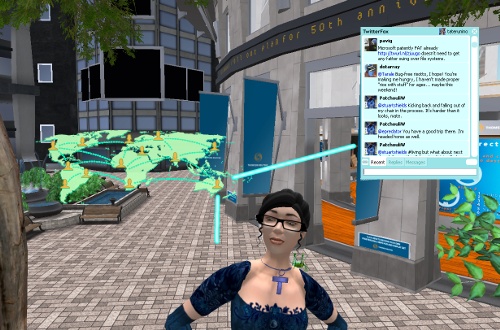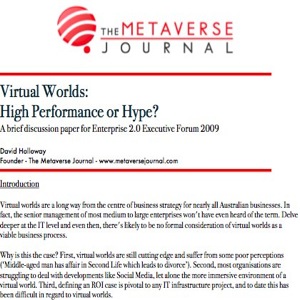1. University World News (USA) – Alliance to create virtual worlds. “A major IT company has teamed up with a Canadian open university to establish a research centre that will create bespoke three-dimensional virtual learning environments. Sun Microsystems of Canada Inc has announced the creation of a new education centre for excellence at Athabasca University, Canada’s Alberta-based open university. Athabasca delivers the bulk of its courses online and the centre will be charged with enabling academics, students, schools and communities to develop virtual world-style online learning platforms. The university will integrate this three-dimensional immersive technology research into its curricula.”
2. Toronto Star (Canada) – Second Life makes classical music fans feel at home. “You can hear the breeze caressing the West Coast pines and the gently rolling sea. High clouds float overhead as people gather in the amphitheatre on Music Island. It is as pretty a spot as one could ever imagine for a concert. Three early-music specialists from Switzerland perform for an hour on recorders and flutes to an audience of listeners from Philadelphia, North Dakota, Norway, Finland, Holland, Italy, France, China, Korea – and Toronto.”
3. ScienceNews (USA) – Playing for real in a virtual world. “In a virtual setting where fifth-graders become wizards and athletes, and even change sexes, preteens stay true to their real-world selves. Classic sex differences in play preferences, characterized by rough-and-tumble games among boys and intimate conversations among girls, still exist after youngsters adopt a range of personas for virtual encounters, investigators find. Boys who create girl avatars — or computerized altar egos — and girls who create boy avatars still behave consistently with their biological sex, say psychologist Sandra Calvert of Georgetown University in Washington, D.C., and her colleagues.”
4. Game Fwd – Mathew Kumar on Why Virtual Worlds Miss the Mark. “Speaking at an International Game Developers Association (IGDA) Ottawa event on February 26, 2009, Gamasutra contributing editor and one of Canada’s most renowned games journalists Mathew Kumar discussed the place of virtual world games in the video game industry. Not shy to express his dislike for the concept as it has been executed so far, Kumar pointed out some of these games’ essential flaws to an intimate crowd at Ottawa’s bitHeads Studio. The event was organized as part of the Interactive Ontario gTalk game industry speaker series. Kumar was quick to highlight that virtual worlds, which are usually based on social interaction functions, rarely succeed in their goal of being effective vehicles for social interaction. While their developers and marketers portray them as a great way to meet new people, most players don’t take advantage of these features.”
5. CNBC (USA) – Virtual Meetings Get A 2nd Life. “Forget the days of companies flying employees to exotic locales to rally the troops and strategize. Who has the money to sustain that the corporate conference excesses of the past — and big remote gatherings just simply look bad. With companies cancelling Las Vegas meetings and Pebble Beach golf outings, some are finding a new, inexpensive way to gather far-flung employees — virtually, in Second Life. Linden Lab’s virtual world, which is home to 1.3 million regular residents, or avatars, has become the new hot spot for corporate gatherings.”
6. Allakhazam (USA) – Console MMOs: Are We There Yet? “If you’re an MMO player, there’s a good chance you have at least one video game console in your home. Personally, I have a Wii and Xbox 360 on the shelf under my television for those times I just don’t feel like sitting in front of my PC to play games. I even have most of my older systems, ranging back to my original NES, for when I get nostalgic. But with the current trend of companies such as Sony Online Entertainment pushing for console MMOs to become commonplace, will there be a time in the near future where players are more likely to pick up a controller than a keyboard to enter a virtual world? It’s certainly a possibility, but the slumping sales of the PlayStation 3 may make it difficult to entice gamers to try out an MMO from the comfort of their couches when their PCs will do just fine.”
7. ZDNet Asia – Bringing online marketing to life. “he 25-year old founder of Singapore-based Dream Axis, which specializes in creating 3D environments on virtual platforms such as Second Life, sees much potential in the 3D online space as a marketing platform for companies. Soh told ZDNet Asia in an interview: “There is so much opportunity for Web 2.0 to move to Web 3.0, where social collaboration in the 2D space goes to 3D.” Dream Axis recently completed building a set of islands for the National University of Singapore. The tertiary institute last year developed the online replica of its campus in an effort to reach out to potential students.”
8. Earth2Tech (USA) – Geekout: Sun, Second Life & Green Data Centers. “It’s the geekiest thing I’ve ever done: I just watched Sun Microsystems give a tour of its green data center designs in Second Life via a Ustream feed. Complete with Sun execs flying between data center designs, chuckling about their virtual outfits, and red (hot) and blue (cold) air flow designs emanating from the server gear, the media event lasted about 45 minutes. That was about 45 minutes too long (kidding!), as it was actually pretty hard to hear or understand what was going on. I’m going to wait for a “first life†tour in Santa Clara some day.”
9. Business Insider (USA) – IBM: We’re Still Committed To Virtual Worlds. “Earlier this week, we wondered if the departure of IBM’s (IBM) “Metaverse Evangelist” means the company is scaling back its interest in virtual worlds and Second Life. We haven’t heard much from the group in months, which only added to our speculation. IBM reps finally got back to us, and they let us know they’re still in there”
10. Telepresence Options – Holograms: coming soon to your front room? “I’ve done some daft things in my time, but inter viewing someone who wasn’t there for the best part of an hour must be in a class of its own. The person in question, Ian O’Connell, director of London-based Musion, wasn’t  invisible. I could follow his every movement, gesture and eye motions: it was just that he himself was somewhere else. I was chatting to one of his company’s products, or maybe I should say non-products: a hologram.”

 Today, I had the pleasure of facilitating four small group sessions at the
Today, I had the pleasure of facilitating four small group sessions at the Aside from the group discussions on virtual worlds I facilitated yesterday, the only other time I witnessed them discussed at the
Aside from the group discussions on virtual worlds I facilitated yesterday, the only other time I witnessed them discussed at the  If you’re a Mac user, you know you’ve got access to a whole slew of first-class applications. That is, apps that follow the user-interface style guidelines for the Mac. Painstakingly developed and tested over time, the guidelines ensure consistent layouts of menus, options and hotkeys, so that you don’t spend your time struggling to work out how to do the familiar, when you should be getting on with gaining expertise in the unfamiliar.
If you’re a Mac user, you know you’ve got access to a whole slew of first-class applications. That is, apps that follow the user-interface style guidelines for the Mac. Painstakingly developed and tested over time, the guidelines ensure consistent layouts of menus, options and hotkeys, so that you don’t spend your time struggling to work out how to do the familiar, when you should be getting on with gaining expertise in the unfamiliar.
Recent Comments